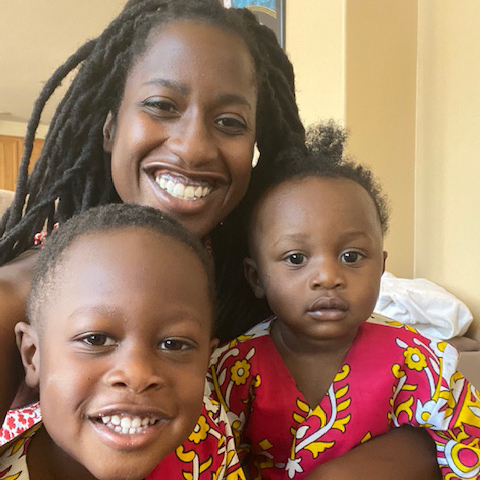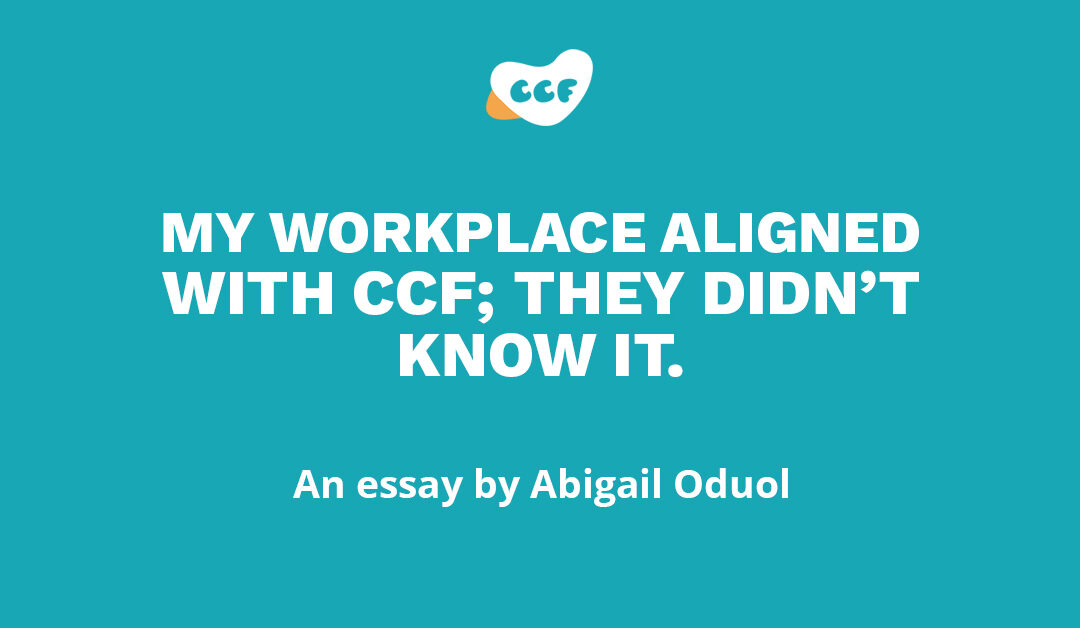By Abigail Oduol, a planned gift fundraiser in California
It is easy to feel frustrated when you are passionate about CCF but your workplace does not seem interested or is hesitant to engage. Do not despair! The people where you work might be more aligned than they initially seem.
What does it mean for a workplace to be Community-Centric Fundraising aligned? We can answer that question in several ways, shown not just by statements, but through how the organization functions and considers others in its engagement.
As I write this, a study is collecting data on how workplaces have implemented CCF now that we are five years into the movement. CCF has spread across the sector and has changed how people talk about fundraising, shifting the conversation from exclusively a donor-centric model to reconsidering what fundraising can look like that includes entire communities.
It is easy to feel frustrated when you are passionate about CCF but your workplace does not seem interested or is hesitant to engage. Do not despair! The people where you work might be more aligned than they initially seem.
The following story is my experience working at a full-service international development and refugee resettlement agency, Church World Service (CWS). They forever changed my expectations of what it means to work in a nonprofit space in a pre-CCF world (2015-2018). This experience was formative in my workplace imagination of nonprofit fundraising before I had the language for it.
History is who we were and who we are.
The first Black institution in Toronto, Canada, First Baptist Church, said something interesting when I visited them earlier this year. They said, and I paraphrase, “We could coast off our amazing history. But we are not going to do that. We will define ourselves by who we are and what we do today.”
During the Civil Rights Movement, CWS paid the salaries of white pastors who were fired from their congregations for wanting to advance Civil Rights. In the 1960s, they started thinking about long-term solutions beyond food aid. They thought about the dignity of the communities they served and engaged with in their photos, and I remember an organizational leader saying they wanted to see “fat happy babies” on fundraising materials rather than people on their worst days. They were using asset-based community development early on.
I learned from CWS to expect nonprofit organizations to grow from just learning about the needs of the community to guiding donors into alignment with the communities’ interests. Program staff I met felt proud to work for CWS because of what their work entailed and how their work was done. They value partnership with other organizations and working together with communities to achieve the community’s goals rather than coming from a perspective of deficit. And one of those communities was proud to see me, a Black American, fundraising and representing the projects they had been working toward in their community.
We have a Black CEO.
…an organization that chooses Black, Indigenous, and People of Color leaders intentionally rather than waiting until a cultural moment happens leaves no doubt in the minds of young staff that not just their skin color, but also their contributions are valued.
Rev. John L. McCullough served as the CEO of CWS from 2000 to 2021. Before Obama. Before George Floyd.
The earliest statistics that I could find stated that in 2004, 84% of nonprofit executives were white, and in the absence of the corresponding board statistic, I doubt it was different. I remember feeling incredibly excited to meet a Black CEO for the first time in my life. When I went on donor visits with him and the chair of the board—also a Black man at the time—walking into donors’ homes in the Pacific Northwest felt powerful and amazing.
Riding around, we talked about the history of racism in the area, shared stories of uncomfortable donor interactions, and spoke about keeping our identities while representing an organization that meant many things to many people. He asked me for feedback from our donor visits and how he could improve. He also came to a donor presentation of mine and gave public speaking advice, advising me to know my material in and out so that I can be flexible in my delivery.
To receive mentorship moments from someone who was several degrees removed from my entry-level fundraising role taught me that regardless of a role that someone holds in a hierarchical structure, they can make choices to be accessible to workers. They can take feedback and use it to improve their work.
And an organization that chooses Black, Indigenous, and People of Color leaders intentionally rather than waiting until a cultural moment happens leaves no doubt in the minds of young staff that not just their skin color, but also their contributions are valued.
We don’t need their money.
Sometime around 2016, I was in the Rocky Mountain area for donor visits. I scheduled a visit with a supporter, who we will call Rich, who gave an appreciated asset. I made my way to Rich’s home, his wife opened the door, and I confirmed that I was the fundraiser who had set up the meeting. After reminding them of the reason for the stewardship visit, I thanked the donor for their gift and asked what inspired their generosity.
It turned out the asset he had donated was Confederate memorabilia that he had sold to fund the work of the organization. I was surprised. Then, he shared that he had family members who fought for the Confederacy and that he agreed with their cause. He monologed Lost Cause propaganda (a myth pro-confederates came up with to explain the South’s defeat in the Civil War and to romanticize a pre-Civil War South) for what felt like an hour. I was uncomfortable and tried to pivot to another topic. No luck. His wife was uncomfortable. She said something to the effect of, “Honey, why don’t we hear about why Abigail is here.”
He was not interested in our attempts to salvage the situation and had decided that I, the Black fundraiser, and captive audience, needed to hear what he had to say.
When Rich finally took a breath after saying he would not be making any more donations, I thanked the couple for their past support and left, now late for my next meeting. I called my supervisor at once to tell him what happened. I was so relieved to have him respond immediately, affirming I did not have to tolerate that sort of behavior. He shared that I had the organization’s full permission if a donor behaved in that way to stand up and leave. We removed Rich from my portfolio, and the supervisor said we did not need money from people who behaved like that.
This was not the last time that something like this would happen in my fundraising career, and I was grateful to have a supervisor modeling how to give as much care to staff as we give to donors.
What does your organization do when donors behave badly toward staff? Do you hire racialized minorities, immigrants, and people with marginalized gender identities and disabilities but then let them die a death by a thousand cuts by how donors wield power over them?
We bend the system to our will.
In 2017, my mom received a cancer diagnosis. At the time, I was an out-the-door fundraiser who frequently traveled to meet supporters across a wide geography. I was also her only local child, so I worked hard to manage her treatment schedule with work demands and her increasing care needs.
In 2018, I was doing all of it while pregnant. I knew that my mom had an upcoming bone marrow transplant, and I had an upcoming delivery, so I budgeted my sick time and Family and Medical Leave Act allowance so that I’d spend some time being my mom’s caregiver and the remainder of the time a few months later caring for my new baby. I worked with HR and supervisors in making these plans, and they almost worked. Almost.
Shortly after my baby was born, my mom’s cancer returned aggressively. For several months, I was taking care of her, a newborn, and recovering from an emergency surgery. Then, the unthinkable happened. The doctor told her she had a year left to live and that she needed 24-hour care, so she moved into my apartment. She died within three weeks. My baby became sick with pneumonia days later.
I was so tired. I was grieving.
We felt like our joy at a new baby, and my mom’s remission had turned into a heavy, suffocating curtain. I had to navigate through the incredibly bureaucratic process of probate because my mom hadn’t written a will yet. And I had no more leave left.
Human Resources and supervisors worked with me to make sure I had time to plan the funeral and grieve my mom. They sent flowers and a representative to my mom’s funeral. They invited my colleagues to donate their sick leave so that I could take some added time from work. And when it became clear that my life had changed so much that I could not meet the requirements of my job in the same way I had before, they worked with me to be fully remote from home as I looked for another job.
What does it all mean?
What does it mean to be a part of the CCF community? What is the right cocktail of engagement, learning, and reflection of an individual or of a nonprofit?
Whatever it means, it should be tangible. We should feel it when we interact with donors, other organizations, and each other. We should care about making the organization a place that people want to come to and stay at. People should be forming memories in their workplace of how it is the best place they have ever worked or the best people with whom they have ever worked.
It is less virtue signaling and more engaging in the process of becoming. I do not think CWS considers itself a CCF fundraising shop. But I believe if they do choose to adopt CCF principles, they will be surprised by the alignment and how they have already made choices that engage in that process of becoming.
I hope everyone has the chance to have work experiences like these, where the challenging moments are minimal compared to the grace and care with which they were addressed. It is a wonderful thing when we can co-create workplaces that reflect shared values. There is no perfect workplace, of course, as there are no perfect people, but using CCF principles and learning how others are practicing them can act as a light, illuminating the dark corners of our nonprofits where we’ve collectively struggled. They guide us where we’re falling short and reflect off of our faces as we collectively glow and grow to be better people and places to work.

Abigail Oduol
Abigail Oduol’s (she/hers) surname is not Irish or Pennsylvania Dutch. It’s Kenyan. She keeps her escape pod in Kenya ready, and checks on it regularly with her young kids and husband. Abigail serves on the CCF Global Council, NACGP D&I committee and with her local PTA. You can follow her on LinkedIn, and can send tips and micro reparations to her Cashapp $AbbyOduol.
Discover more from CCF
Subscribe to get the latest posts sent to your email.


Abigail, I so appreciate you sharing your story of such a wonderful workplace. As someone who often focuses on critique, on what can be better, on pursuing justice…sometimes it’s hard for me to see the joyful moments. Thank you.
Yes! I agree. I’ve had a shift recently where I’ve reflected on things past and present that had a beautiful element and I’ve begun to believe that cultivating this is a part of the long term fight.